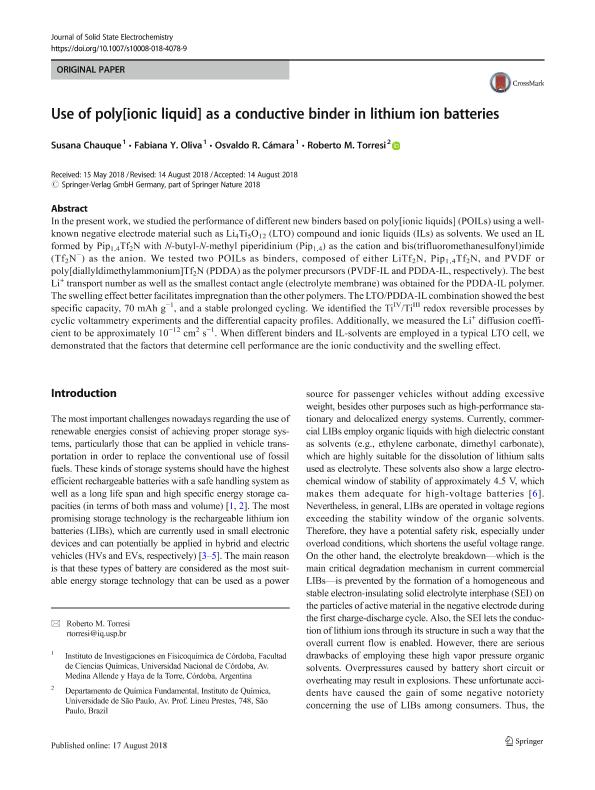Artículo
Use of poly[ionic liquid] as a conductive binder in lithium ion batteries
Fecha de publicación:
11/2018
Editorial:
Springer
Revista:
Journal of Solid State Electrochemistry (print)
ISSN:
1432-8488
e-ISSN:
1433-0768
Idioma:
Inglés
Tipo de recurso:
Artículo publicado
Clasificación temática:
Resumen
In the present work, we studied the performance of different new binders based on poly[ionic liquids] (POILs) using a well-known negative electrode material such as Li4Ti5O12 (LTO) compound and ionic liquids (ILs) as solvents. We used an IL formed by Pip1,4Tf2N with N-butyl-N-methyl piperidinium (Pip1,4) as the cation and bis(trifluoromethanesulfonyl)imide (Tf2N−) as the anion. We tested two POILs as binders, composed of either LiTf2N, Pip1,4Tf2N, and PVDF or poly[diallyldimethylammonium]Tf2N (PDDA) as the polymer precursors (PVDF-IL and PDDA-IL, respectively). The best Li+ transport number as well as the smallest contact angle (electrolyte membrane) was obtained for the PDDA-IL polymer. The swelling effect better facilitates impregnation than the other polymers. The LTO/PDDA-IL combination showed the best specific capacity, 70 mAh g−1, and a stable prolonged cycling. We identified the TiIV/TiIII redox reversible processes by cyclic voltammetry experiments and the differential capacity profiles. Additionally, we measured the Li+ diffusion coefficient to be approximately 10−12 cm2 s−1. When different binders and IL-solvents are employed in a typical LTO cell, we demonstrated that the factors that determine cell performance are the ionic conductivity and the swelling effect.
Palabras clave:
POLY[IONIC LIQUIDS]
,
LITHIUM BATTERIES
,
BINDER
Archivos asociados
Licencia
Identificadores
Colecciones
Articulos(INFIQC)
Articulos de INST.DE INVESTIGACIONES EN FISICO- QUIMICA DE CORDOBA
Articulos de INST.DE INVESTIGACIONES EN FISICO- QUIMICA DE CORDOBA
Citación
Chauque, Susana; Oliva, Fabiana Yolanda; Camara, Osvaldo Raul; Torresi, Roberto M.; Use of poly[ionic liquid] as a conductive binder in lithium ion batteries; Springer; Journal of Solid State Electrochemistry (print); 22; 11; 11-2018; 3589-3596
Compartir
Altmétricas




